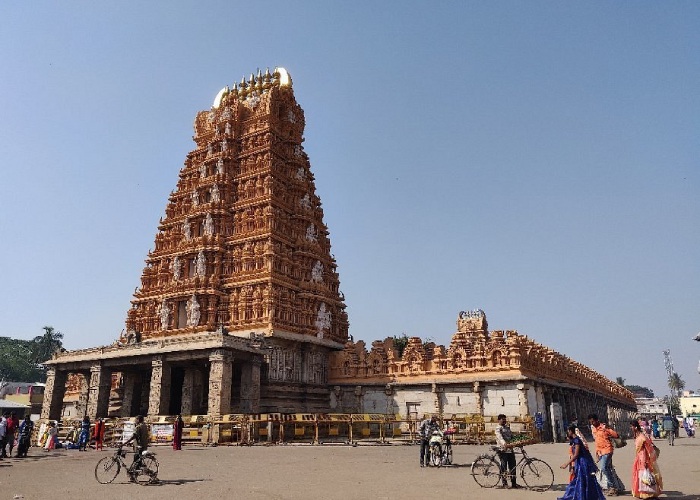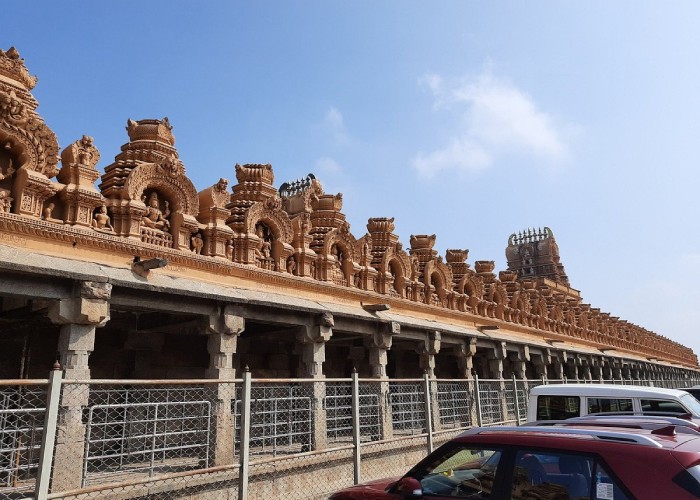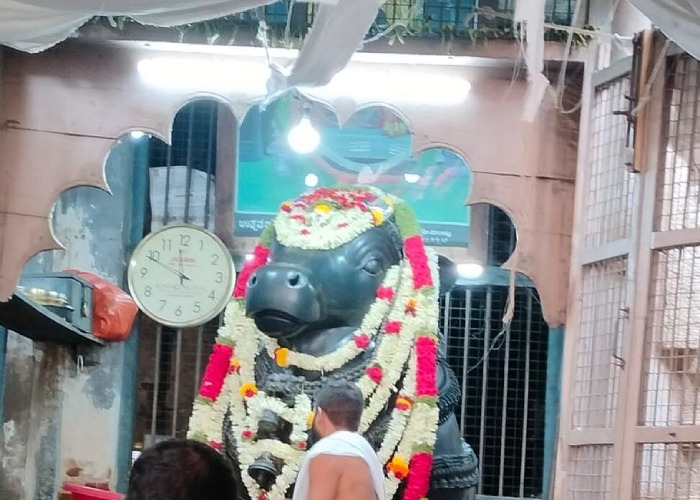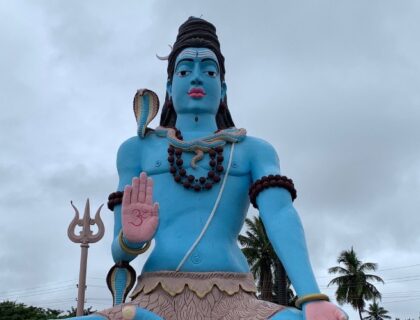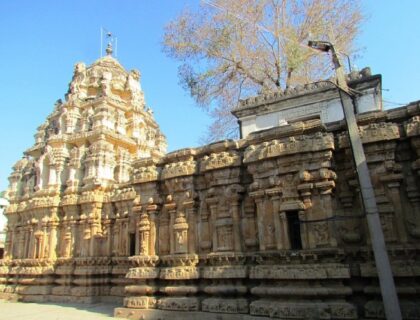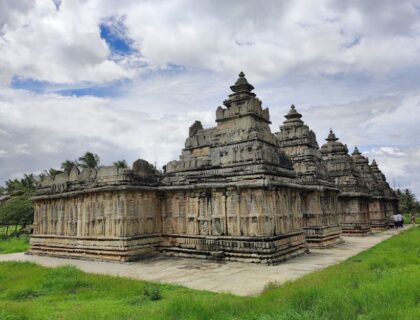Srikanteshwara Temple Nanjangud
The Srikanteshwara Temple (also called Nanjundeshwara Temple) is an ancient temple dedicated to Shiva in the Hindu pilgrimage town of Nanjanagudu in Karnataka, India. It is located on the right bank of the Kapila River, a tributary of the Kaveri River. Nanjanagudu is also known as “Dakshina Prayaga” or “Prayag of South”.
Nanju in Kannada means “to poison”. The name Nanjundeshwara means the “God who Drank the Poison” (halāhala, a word that has its origins in the legend of the Great Churning of the Ocean of Milk); thus, the town got the name “Nanjanagudu” which means “the abode of the god Nanjundeshwara”.
Legend Related to Srikanteshwara Temple
According to legend, an Asura named Kesian was extremely venomous and harassed the Devas. The distressed Devas fled to Shiva for protection. He instructed them to perform a yagna at the confluence of the three rivers – Kapila, Koundini, and Manikarnika – and to throw the Asura into the fire pit when he arrived. The Devas followed Shiva’s advice, and when Kesian appeared at the yagna, they threw him into the fire under the guise of welcoming him. God manifested himself as Agni (fire) and destroyed the Asura. After defeating the poisonous Asura, Shiva stayed in the area as a Lingam and became known as Nanjundeshwara.
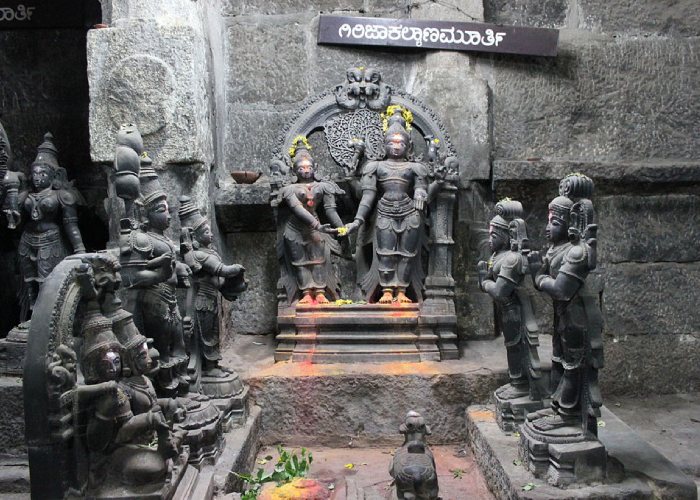
Over time, the Lingam disappeared. Later Parashurama arrived at the place and installed a Shiva Lingam, as penance for having killed his mother, Renuka Devi. He installed the Shiva Lingam and began purifying the place. When he removed the bushes, he found Lingam bleeding. The injury caused by Parashurama is still visible on the Lingam. He was about to end his life for causing injury to the Lingam when God appeared and gave him darshan. It is believed Parashurama built the temple here.
History related to Srikanteshwara Temple
According to local legend, Sage Gauthama established the temple by erecting a Linga in the area. The Gangas constructed a small, square garbhagriha in the ninth century. The Hoysala pillars, like the dancing Ganpati statue, date from the 13th century.

During the Vijayanagara period, architects added the Parvati and Narayana shrines to the temple structure. This era is also represented by the main stucco shikara. The 9-story tall Dravidian-style gopuram was built in 1849 by Krishnaraja Wadiyar III’s queen, Devajammanni. Another key attraction, the tall stone bull in the temple complex was built by Dalavayi Vikramaraya in 1644.
Architecture of Srikanteshwara Temple
The temple is an excellent example of Dravidian architecture. The Rajagopuram is a nine-tiered gateway tower at the temple. Shiva in the form of a Lingam is the presiding deity. He is looking to the north-east. Nandi the bull, his vehicle, is also on the northeast side.

The Garba Griha was constructed during the reign of the Chola kings in the 11th century A.D. During the Hoysala period, around the 13th century A.D., the anterior Mandapam, where devotees can sit, was added. A brick-and-mortar shikhara was built over the shrine during the Vijayanagara period. Later, during the reign of Mysore’s Wodeyar kings, the temple saw further development. The temple’s tower is also considered a Shiva Lingam, and there is a Nandi outside the temple. The Alankara Nandi can be found in the prakaram (corridor) facing the outside.

To the right of the presiding deity’s shrine is the shrine of the Mother Goddess Parvati. Sri Dakshinamurthy and his fourteen disciples grace the temple grounds. There is also a Nandi in this shrine. Sri Narayana’s shrine is located between those of Srikanteshwara and the Mother Goddess. The temple contains the twenty-four forms of Shiva, Tipu Sultan’s Maragatha Lingam, Vennai (butter) Ganapathy, Murugan amidst the serpents, Sri Chandikeswarar in a standing posture, and the Navagrahas.

The temple also houses several, Lingams, Mantapams and carriages on its premises. The Vilva tree is the Sthala Vriksham of the temple. The Theertham associated with the temple is the Munnadhi Sangama confluence of three rivers – Kapila, Koundini and Manikarnika.
Facts about Srikanteshwara Temple
- The Srikanteshwara Temple (also called Nanjundeshwara Temple) is an ancient temple in the Hindu pilgrimage town of Nanjangud in the Karnataka state, Southern India.
- The Srikanteshwara temple in Nanjangudu is the largest in Karnataka, measuring 385 feet by 160 feet and covering a total area of 50,000 square feet.
- Devarajammanni, the queen of Mysore king Krishnaraja Wadiyar III, built the nine-story, 120-foot-tall temple gopuram (gateway tower) and its extensive exterior.
- The Shiva Purana mentions Nanjungud as Sri Garalapuri. The legendary holy place is said to be Shiva’s abode in southern India.
- It is also known as “Dakshina Kasi,” because the god appeared at the request of his devotees, the Devas, and sage Narada.
- There are numerous minor shrines in the temple, including Narayana with consorts, Chandikeswara, Parvathi, Natya Ganapathi, and others.
- Many more lingas, mantapas, vahanas (carriages), and Uthsava Murthis (idols used during procession) can be found here.
- The Parashurama Kshetra is located on the banks of the Kapila, and many people believe that a pilgrimage to Nanjangudu would be incomplete without a prayer here.
- Other temples dedicated to Gauthama, Ganapathi, and Dattatreya include the Raghavendra Swami Mutt and the Virasaiva Mutts.
- Another important centre in Nanjangud is the Raghavendra Math, situated on the road to the right of the Nanjundeswara temple.
- A popular variety of banana locally known as Nanjangud Rasabaley has also made Nanjangud famous all over the region.
- Every day, Sri Srikanteshwara is worshipped through Abhisheka and Pooja according to Saivagama. Mondays, New Moon days, and Full Moon days are especially auspicious.
Best Time To Visit Srikanteshwara Temple
This temple’s journey can be taken at any time of year. All of the time, the weather is warm and hospitable.
Famous Festivals In Srikanteshwara Temple
Millions of people visit this temple every year to celebrate all of the festivals that are held here. Some major festivals held here are
- Rathotsava Festival – The Rathotsava or Nanjundeswara car festival, the ‘big Jathra’ (big car festival), and the ‘chikka Jathra’ (small car festival) are some of the grandiose festivals celebrated in this place.
- Shravan Month – This month is considered the holiest month for lord Shiva devotees.
- Mahashivratri – Mahashivratri, “The Great Night of Shiva” is the most significant event in the Indian Hindu calendar.
How to Reach Srikanteshwara Temple
By Air: The nearest airport to the temple is the airport at Mysuru.
By Railway: The closest railway station to the temple is the Nanjangud Railway Station.
By Roadways: There are a number of local buses that connect Nanjangud with places nearby like Bokkalli, Mudahalli, Hulimavu and Hadinaru.
Also, Read – Brihadeeswara Temple Thanjavur
Location
Facilities
- Drinking Water
- Pooja Item Shops
- Prasad Shops
- Restaurants Nearby
- Resting Room





